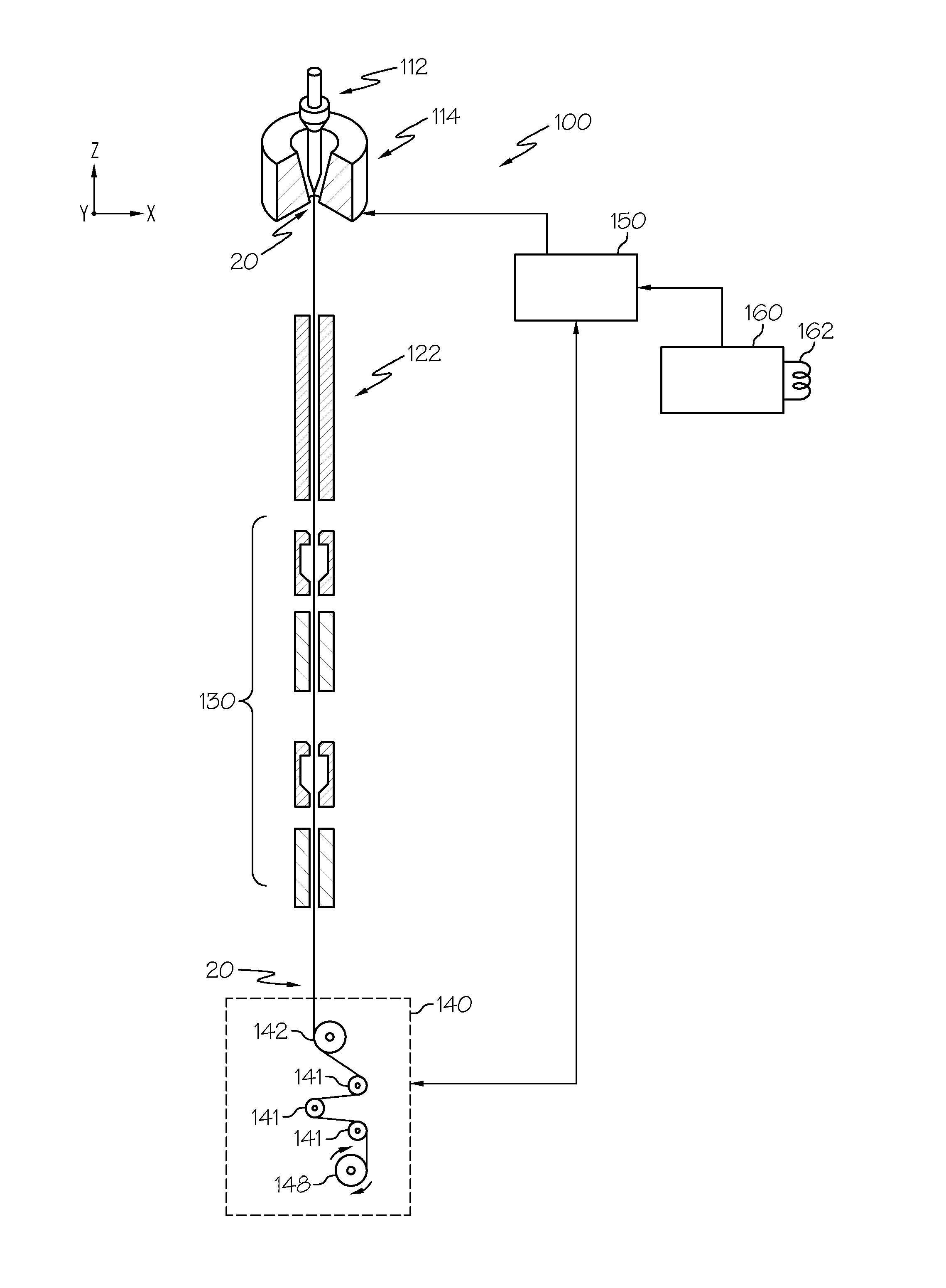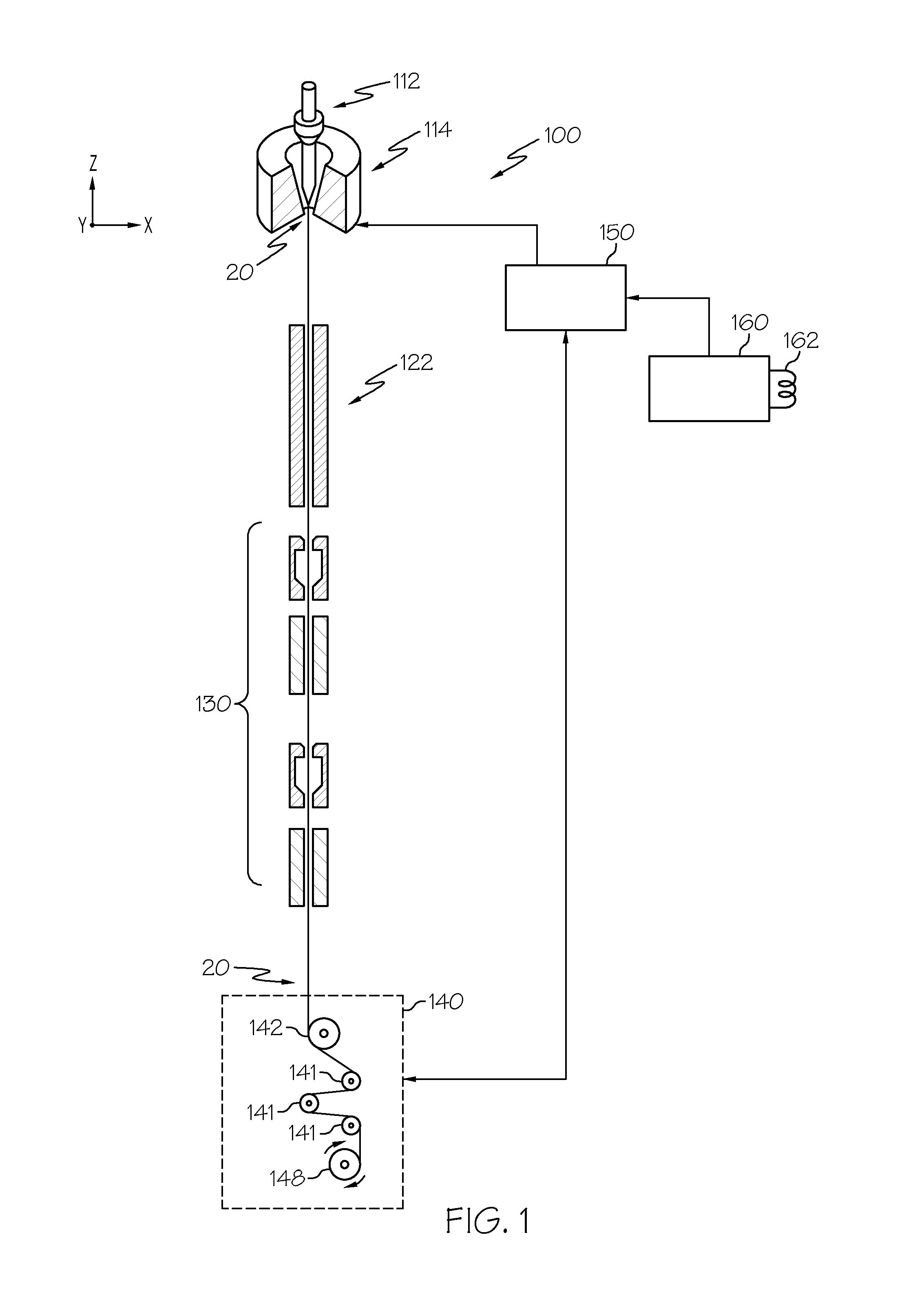Methods for modifying multi-mode optical fiber manufacturing processes
a multi-mode optical fiber and manufacturing process technology, applied in the direction of manufacturing tools, optical apparatus testing, instruments, etc., can solve the problem that conventional fiber manufacturing processes may not consistently produce fiber that satisfies desired performance characteristics, and achieves the effect of maximizing the bandwidth function
- Summary
- Abstract
- Description
- Claims
- Application Information
AI Technical Summary
Benefits of technology
Problems solved by technology
Method used
Image
Examples
example 1
[0072]In one example, a number of multi-mode optical fibers were drawn at different drawing tensions, the measured peak wavelength of each of the four drawn multi-mode optical fibers was determined, a function defining the relationship between drawing tension and peak wavelength was established, the measured peak wavelength of a test segment of drawn fiber was determined, a difference between a target peak wavelength and the measured peak wavelength of the test segment was determined, and the process for manufacturing multi-mode optical fiber was modified based on the difference between the target peak wavelength and the measured peak wavelength, as will be described in further detail below.
[0073]As noted above, in this example, a number of multi-mode optical fibers were drawn at different drawing tensions. Four multi-mode optical fibers were drawn at a draw speed of about 70 meters per minute. The drawing tension of each of the four multi-mode optical fibers was adjusted by adjusti...
example 2
[0077]In another example, a number of optical fibers were drawn to have peak wavelengths at several target peak wavelengths. The modal bandwidth of each of the fibers was measured using a ModCon multimode fiber conditioner, commercially available from Ardent, which creates a typical multimode fiber launch condition as typically seen in VCSEL-based laser sources. To evaluate the ability to achieve various target peak wavelengths, drawing tensions were adjusted based on a function that defines the relationship between the change in drawing tension and the change in peak wavelength. The function defining the relationship between the change in drawing tension and change in peak wavelength may be any of the functions described above, or any other mathematical or empirical relation that maps target peak wavelength to drawing tension. The peak wavelength of each of the fibers was then measured to determine how close the measured peak wavelength was to the target peak wavelength. Specifical...
example 3
[0078]In another example using another preform, a fiber was drawn at a specified drawing tension of 147 g. After 20 km of the fiber was drawn, a first 1 km fiber sample was taken and the peak wavelength was measured to be 848 nm with peak bandwidth of 7.18 GHz*km and bandwidth at 850 nm to be 7.16 GHz*km. The draw tension was reduced by 17 g tension (to 130 g), resulting in a target peak wavelength of 873 nm. The peak wavelength of the fiber was measured to be 871 nm for a second 1 km sample after the adjustment in the tension. The measured peak wavelength of 871 nm is within 2 nm of the target peak wavelength, demonstrating the ability to tightly control peak wavelength. The peak bandwidth of the second fiber sample was 8.13 GHz*km with a bandwidth at 850 nm of 6.62 GHz*km. The draw tension was then increased by 14 g (to 144 g), resulting in a target peak wavelength of 850 nm. After waiting a few minutes to allow the tension to stabilize, a third 1 km sample fiber was taken, the pe...
PUM
| Property | Measurement | Unit |
|---|---|---|
| Wavelength | aaaaa | aaaaa |
| Wavelength | aaaaa | aaaaa |
| Temperature | aaaaa | aaaaa |
Abstract
Description
Claims
Application Information
 Login to View More
Login to View More - R&D
- Intellectual Property
- Life Sciences
- Materials
- Tech Scout
- Unparalleled Data Quality
- Higher Quality Content
- 60% Fewer Hallucinations
Browse by: Latest US Patents, China's latest patents, Technical Efficacy Thesaurus, Application Domain, Technology Topic, Popular Technical Reports.
© 2025 PatSnap. All rights reserved.Legal|Privacy policy|Modern Slavery Act Transparency Statement|Sitemap|About US| Contact US: help@patsnap.com



